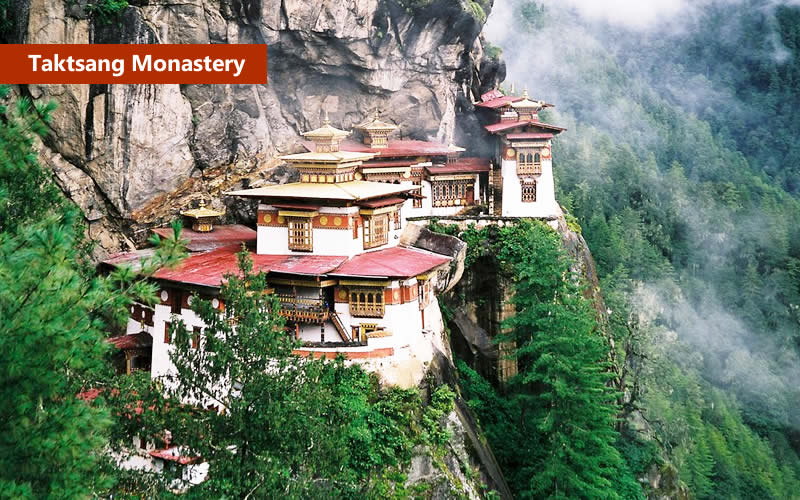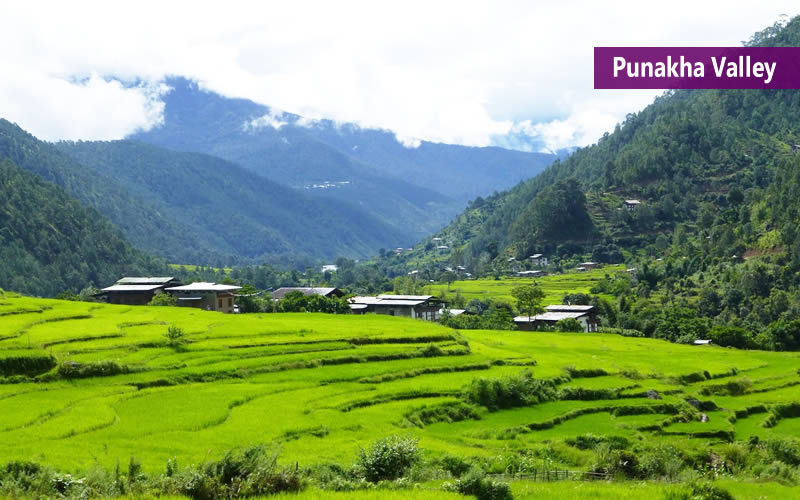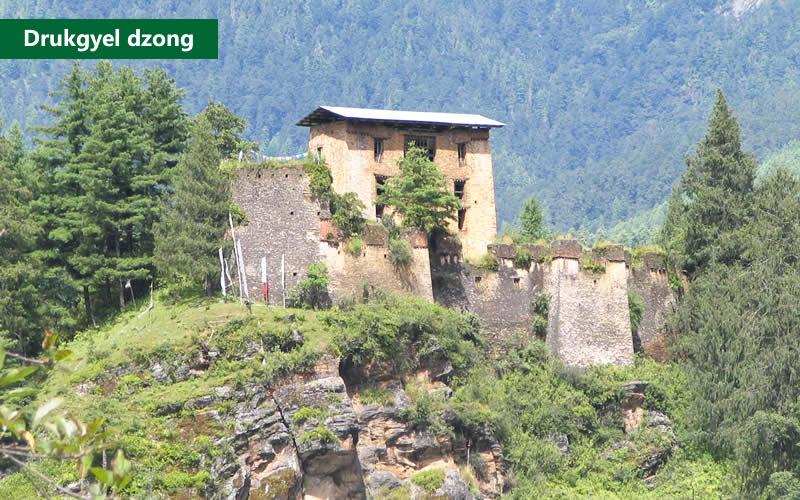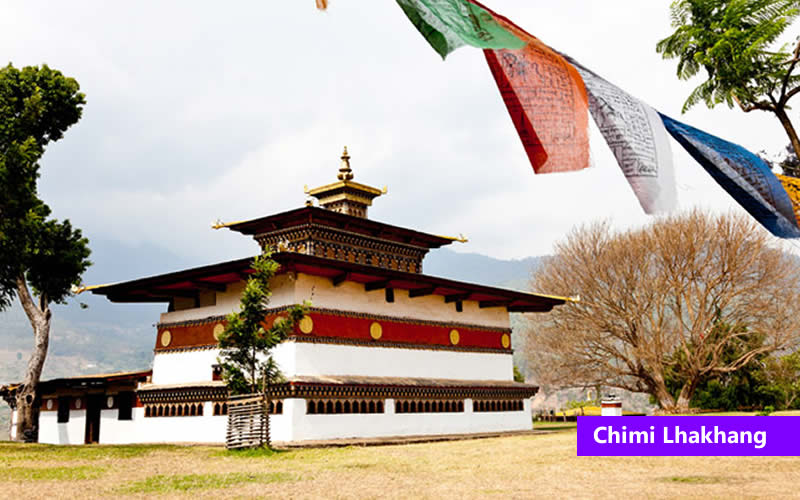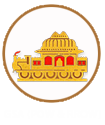BHUTAN – THE LAND OF THUNDER DRAGON
- Day 01: Arrive Paro by druck air & drive to Thimpu
- Day 02: Thimpu
- Day 03: Thimpu
- Day 04: Thimpu - Punakha
- Day 05: Punakha
- Day 06: Punakha - Paro
- Day 07: Paro
- Day 08: Paro
- Day 09: LV Pairo
Tour Highlights:
Tour Schedule - BHUTAN – THE LAND OF THUNDER DRAGON
DAY 01: ARRIVE PARO by Druck Air & DRIVE TO THIMPU
- The flight into Bhutan takes you close to the great Himalayas, offering dazzling scenic views of some world’s highest glacial peaks. As you enter Paro valley, you will sweep past forested hills with the silvery Pa Chu (Paro river) meandering down the valley below. Paro Dzong (fortress) and Ta Dzong (watchtower) on the hills above the town will be a fine sight.
- On arrival you will process your visa at immigration (clearances will be obtained by us in advance).
- At the airport you will be received by our representative with a “Tashi khaddar “(White scarf offering to the guest which is a auspicious way to welcome guest).
- Straight from the airport you will drive to Thimpu, the capital town of Bhutan. This journey of 54 kilometers (34 miles) will take you around 2 hours.
- THIMPU – Thimpu is the center of government, religion and commerce for this small mountain kingdom, Thimphu is a lively place, an interesting combination of tradition and modernity. Home to civil servants, expatriates and the monk body, Thimphu maintains a strong national character in its architectural style.
- This evening enjoy a traditional cultural performances by local artists from Royal Academy of Performing Arts. Feel free to join in the fun for yourselves. A welcome cocktail with local alcohol will be served followed by dinner at the Hotel.
- Overnight at the hotel in Thimphu
DAY 02: THIMPU
- Today’s full day of sightseeing in Thimphu valley will be your first real introduction to the way of life in this peaceful part of the world.
- Visit the National Library. Established in the late 1960s primarily to conserve the literary treasures which form a significant part of Bhutan’s cultural heritage, the National Library now houses an extensive collection of Buddhist literature mostly in block-printed format, with some works several hundred years old.
- This collection, known as the Choekey Collection, mainly comprises Buddhist literature written in Choekey, the religious script of Northern Buddhism, but also includes works written in Tibetan and in Dzongkha, Bhutan’s national language.
- There is also a small Foreign Books Collection, stock of which mainly comprises works written in English, with subject interest on Buddhist studies, Bhutan, the Himalayan region and neighboring countries.
- A special visit this day will be to the Institute for Zorig Chusum: Commonly known as the Painting School, the Institute offers a six-year course on the 13 traditional arts and crafts of Bhutan. This is quite a unique place and we’ll organise your visit to actually see students producing intricate designs.
- Also visit the Textile & Folk Heritage Museum, a fascinating testimony of Bhutan’s living traditions. Lunch would be served at Bhutan Kitchen, a charming place providing Bhutanese delicacies.
- National Memorial Chorten is another stop on the tour: The building of this chorten was originally the idea of Bhutan’s third king, H.M. Jigme Dorji Wangchuck (“the father of modern Bhutan”), who had wished to erect a monument to world peace and prosperity, but was unable to give shape to his idea in his lifetime due to pressures of state. After His Majesty’s untimely death in 1972, the Royal Family and Cabinet resolved to fulfill his wishes and erect a memorial that would perpetuate his memory and also serve as a monument to peace. The National Memorial Chorten was consecrated on July 28, 1974. The finely executed wall paintings and delicately fashioned statues within the monument provide a deep insight into Buddhist philosophy.
- And finally we drive past the Tashichhodzong: The “fortress of the glorious religion”, was initially erected in 1641 and rebuilt by King Jigme Dorji Wangchuck in the 1960s. Tashichhodzong houses some ministries, His Majesty’s secretariat, and the central monk body.
- Tonight’s overnight is in Thimpu.
- Dinner along with a prominent Bhutanese family which provides opportunity to experience traditional Bhutanese hospitality.
- Overnight at the hotel in Thimphu
DAY 03: THIMPU
- After breakfast we shall have a bit of fun this morning. Today we will arrange an archery match for the guest to have the glimpse of our national sport. Guest can start at around 9 am and drive to the archery range. It is a good time to relax and walk around with the archers see how it is done. An early lunch will be served with the archers.
- Alternatively we can arrange Tee times at Golf Course. Bhutan’s 9 hole golf course is located in heart of Thimphu, 2800 m above sea level, with a majestic backdrop of the capital’s administrative Dzong.
- Evening we can organise an interaction program with an expert on desirable subjects like Bhutan‘s history & cultural heritage, Bhutanese Buddhism, Ecology & Environment.
- Overnight at the hotel in Thimphu
DAY 04: THIMPU – PUNAKHA
- The 70 Km (44 mile) drive to Punakha goes via Dochula pass. An hours drive from Thimphu will take you to this pass (3050 meters), from here one can have superb view of the Mountain ranges on a clear day. Drive on to Punakha (1,300m/4,265ft)
- Punakha served as the capital of Bhutan until 1955 and still it is the winter seat of the Je Khenpo (Chief Abbot). Blessed with a temperate climate and fed by the Pho Chu (male) and Mo Chu (female) rivers, Punakha is the most fertile valley in the country.
- Afternoon visit to majestic Punakha Dzong: Placed strategically at the junction of the Pho Chu and Mo Chu rivers, the dzong was built in 1637 by Shabdrung Ngawang Namgyal to serve as the religious and administrative center of the region. Damaged over the centuries by four catastrophic fires and an earthquake, the dzong has been fully restored in recent years by the present monarch.
- Evening we’ll arrange your visit to a farmer’s family to get a glimpse on Bhutan’s rural life.
- Overnight at the hotel in Punakha
DAY 05: PUNAKHA
- Morning take an interesting excursion to Chimi Lhakhang, also known as temple of fertility. Situated on a hillockin the centre of the valley, this temple was built by Lama Drukpa Kunley, also known as Divine Madman. It is about 1.1/2 hour walk fascinating nature walk (including both way).
- Afternoon we shall also visit Wangduephodrang (1,300m/4,265ft). Located south of Punakha and the last town before central Bhutan, Wangdue Phodrang is like an extended village with a few well-provisioned shops. The higher reaches of the Wangduephodrang valley provide rich pastureland for cattle. This district is famous for its fine bamboo work, stone carvings, and slate which is mined up a valley a few km. from the town.
- Wangduephodrang Dzong: Stretched along the hilltop above the confluence of the Punakha Chu and Tang Chu rivers, the imposing Wangduephodrang Dzong is the town’s most visible feature.
- Overnight at the hotel in Punakha
DAY 06: PUNAKHA – PARO
- After breakfast we will drive back to Paro. This 124 Km (78 miles) will take around 5 hours.
- En-route visit Simtokha Dzong: This dzong, built in 1627 by Shabdrung Ngawang Namgyal, stands on a low ridge 8 km. down the valley from Thimphu. The Institute for Language and Culture Studies is located here.
- The most noteworthy artistic feature of this dzong is the series of over 300 finely worked slate carvings behind the prayer wheels in the courtyard. Afternoon for spa activities.
- We also recommend traditional hot stone bath.
- Overnight at the hotel in Paro
DAY 07: PARO
- Paro lies at a height of 2,200m/7,218ft. This beautiful valley encapsulates a rich culture, scenic beauty and hundreds of myths and legends. It is home to many of Bhutan’s oldest temples and monasteries, the country’s only airport, and the National Museum.
- Mt. Chomolhari (7,300m) reigns in white glory at the northern end of the valley, its glacial waters plunging through deep gorges to form the Pa Chu (Paro river). The Paro valley is one of the kingdom’s most fertile, producing the bulk of Bhutan’s famous red rice from its terraced fields.
- Your sightseeing today will include
- Drukgyel Dzong:Located 15 KM away towards north. This dzong, with a picturesque village nestling below its ramparts, was built in 1646 by Shabdrung Ngawang Namgyal to commemorate his victory over the Tibetan invaders. Though largely destroyed by fire in 1951, the towering outer walls and central keep remain an imposing sight. On a clear day, there is a splendid view of Mt. Chomolhari from the approach road to Drukgyel Dzong.
- Rinpung Dzong: The “fortress of the heap of jewels“ was built in 1646 by Shabdrung Ngawang Namgyal on a hill above the township. The approach to the Dzong is through a traditional covered bridge (called the Nemi Zam) and then up a paved stone path running alongside the imposing outer walls. The valley’s annual springtime religious festival, the Paro Tsechu, takes place in the courtyard of the dzong and on the dance ground on the hillside above.
- Ta Dzong: On a ridge immediately above Rinpung Dzong is Ta Dzong, built as a watchtower to protect Rinpung Dzong. (“Ta” means “to see” in Dzongkha, so the watchtower of a dzong is always called a “Ta dzong”). On account of their function, watchtowers are always round in shape. In 1968 Paro’s Ta Dzong was inaugurated as the National Museum, and now holds a fascinating collection of art, relics, religious thangka paintings, Bhutan’s exquisite postage stamps, coins and handicrafts, together with a small natural history collection.
- Farm Houses: The natural beauty of Paro valley is enhanced by picturesque farm houses dotted about the fields and on the hillsides. The two to three-storied Bhutanese farm houses are handsome in appearance, with colorfully decorated outer walls and lintels, and are traditionally built without the use of single nail. All houses follow the same architectural style. A visit to a farm house gives an interesting glimpse into the lifestyle of a farming family.
- Evening take a stroll around Paro’s main street visiting local bazaar. It provides ample photo opportunity and intermingling with local people.
- Overnight at the hotel in Paro
DAY 08: PARO
- Morning take part in special puja / meditation under guidance of Bhutanese lama with focus on deliverance from bad spirits, the promotion of long life, the cleansing of the spirit or even a desire for prosperity.
- Later hike to Taktsang Monastery. This most famous of Bhutan’s monasteries is perched on the side of a cliff 900m above the Paro valley floor. It is said that Guru Rinpoche arrived here on the back of a tigress, and meditated at this place, hence the monastery is also called ‘Tiger’s Nest’. This site, which has long been recognized as a most sacred place, was visited by Shabdrung Ngawang Namgyal in 1646, the religious and temporal ruler of Bhutan. It is a place of pilgrimage which Bhutanese try to visit at least once in a lifetime.
- In April, 1998 a fire severely damaged the main structure of the building but now it has been fully restored to its original grandeur. The excursion up to the cafeteria which is situated on a rocky outcrop across a ravine from the monastery, takes about five hours round trip.
- Though the climb is steep, the journey is most worthwhile on account of the superb views en route and especially from the cafeteria viewpoint itself. Also horses can be arranged for this excursion.
- Overnight at the hotel in Paro
DAY 09: LV PARO
- After early breakfast in the hotel, drive to the airport for flight to onward destination.
*Note: All flight details and timings are subject to change.


